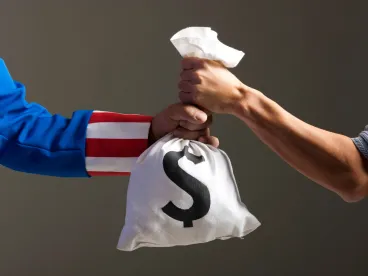The Department of Justice has issued its annual press release touting its False Claims Act recoveries from 2015. The government’s haul was substantial: just over $3.5 billion. This is the fourth consecutive year that recoveries were at or above this level, but represents a significant decline from the government’s record $6.1 billion total recovered in 2014.
There are three major takeaways from the DOJ’s press release. First, the vast majority of FCA recoveries in 2015, like in 2014, came from the health care industry and government contractors. Second, the 2015 recoveries show a DOJ commitment to using the FCA against non-traditional FCA defendants, such as mortgage originators or crop insurers, even though those recoveries account for a significantly smaller share of the funds recovered. Third, the DOJ, following the Yates memorandum, is beginning to use the FCA more as a weapon against individuals, not just corporations.
1. Massive Recoveries in Health Care and Government Contracting Industries
Of the $3.5 billion recovered in 2015, over $3.0 billion came from the health care and government contracting industries. $1.9 billion came from health care; $1.1 billion from government contractors. These two industries have been the bread and butter of the DOJ’s FCA enforcement strategy. Since 2009, the government has recovered $16.5 billion from the health care industry, which accounts for more than half of the dollars recovered since the 1986 amendments to the FCA. One of the most notable recoveries from 2015 included a $250 million settlement with several hundred hospitals. We covered that settlement on our blog earlier last year.
One thing to keep in mind is that many of these health care and government contracts settlements involve allegations that a health care provider or contractor falsely certified compliance with a statute, regulation, or contract provision (so called “false certification” cases). These cases fall into two categories: express false certifications and implied false certifications. The Supreme Court of the United States is currently considering a case that could limit liability under an implied false certification theory. It will be interesting to see whether the Court’s holding in this case will affect future recoveries under the FCA. We previously covered the Court’s decision to grant the petition for a writ of certiorari, and will be providing updates as the case progresses through the Court.
2. The DOJ Remains Committed to Using the FCA Against Non-Traditional FCA Defendants
Government contractors and members of the health care industry found themselves eclipsed in 2014 by a new class of FCA defendant: financial institutions. In 2015, financial institutions continued to be a focus of the government’s enforcement strategy, but they accounted for a much smaller share of total recoveries than they did in 2014. Cases against financial services firms tend to arise out of alleged false certifications of compliance with the rules promulgated by various federal mortgage or mortgage insurance programs.
Another type of non-traditional case, similar to those false certification cases against financial institutions, are cases against insurance companies. We covered one such case that dealt with false certifications of compliance with the federal crop insurance program. That case resulted in a $44 million settlement, which was one of the largest of its kind.
3. The FCA Will Increasingly Be Used to Target Individuals, Not Just Corporations
The final take away from the DOJ’s press release is its explicit warning that it will use the FCA to target individuals, not just corporations. That the DOJ even mentions this shows that the implementation of the Yates memorandum—a memorandum directing U.S. Attorneys to focus on holding individuals accountable for corporate wrongdoing—is already taking place.
Indeed, it appears that the Yates memorandum, and not the dollar value of recoveries against individuals, is what is driving the Government’s focus on individual FCA defendants. Recoveries against individuals are relatively small compared to those obtained from corporations. The ones highlighted in the press release are, with one exception, only for a few million dollars, which is only a tiny fraction of total recoveries. The only reason the DOJ is highlighting these recoveries is to make a point that the dollar value of recoveries is not the sole factor in determining how the government will allocate its resources to fight fraud.



 />i
/>i


